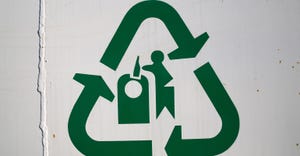December 1, 1996
Dianne De Roze
If you think co-collection and dual-collection are the same thing, read on.
Both systems consist of at least two waste streams that are collected in a single pass. However, while dual-collection consists of different waste streams being collected in a single, compartmentalized packer body, co-collection can include a traditional packer truck and a trailer attached to the truck for recyclables.
Since dual-collection systems require the purchase of a new packer body or modification to existing packers, co-collection equipment costs can be significantly lower, but dual collection systems tend to have higher productivity levels.
Understanding the cost and performance differences of co- and dual-collection is essential when pricing systems.
Both dual-collection and co-collection systems are based on the fact that it is cheaper to run one rather than two trucks down the same streets. At first, few managers were willing to invest the necessary capital for a relatively untested technology.
Now, however, increased pressure to reduce collection costs and the commercialization of a variety of dual-collection techniques has spurred innovations in the development of several dual-collection systems. Despite this, it was estimated that fewer than 100 dual-collection systems were in operation, as of October 1995.
The variety of dual-collection vehicles include combinations of rear-, side- and front-load, and manual, semi- and fully-automated. Recyclables separation in dual-collection systems range from curbside sort systems to commingled. Crew sizes can range from one to three people, depending on the degree of automation, amount of curbside sorting required and the materials collected.
One successful dual-collection strategy is in force in Loveland, Colo., a city of 43,000. In 1990, before implementing manual dual-collection of residential solid waste (RSW) and recyclables, variable rate pricing and separate yard waste collection, Loveland only provided manual curbside residential solid waste collection and drop-off recyclables collection.
During the 31 months of the new system's implementation, Loveland served approximately 13,300 single-family homes.
Loveland's rationale for change was not unique, considering what it faced: an aging truck fleet, rising worker compensation rates due to manual collection injuries, the drive to reduce set-out weights by phasing in separate yard waste collection, low morale, complaints about the flat fee system's equity and the desire to implement a curbside, residential recyclable collection program.
Based on an internal analysis, Loveland estimated that a switch to dual-collection could save approximately $100,000 per year. Semi-automated residential and recyclable collection was considered and rejected by city officials to avoid the initial cost and labor burden of purchasing and distributing differently-sized containers and recycling bins.
In addition, once yard waste was segregated from the waste stream, back injuries that were attributed to manual collection would decrease, slashing high workers comp costs.
Based on local conditions, Love-land decided to purchase manual dual-collection trucks from May Manufacturing, Arveda, Colo., for residential waste and recyclables, and semi-automated trucks for yard waste collection.
The decision to use manual, dual-collection instead of semi-automated collection has saved the city an estimated $1,000,000 in capital costs.
System Savings The city installed a $4.10 flat monthly fee on utility bills to cover curbside residential recyclables collection and drop-offs for recyclables, household hazardous waste and yard waste. This fee did not include an optional $4 yard waste collection fee.
In addition to the monthly charge, city residents pay $1 for ten 32-gallon bags and 55 for each 15-gallon bag. The bags are purchased by the city and are sold at local retailers. The bag fee is designed to cover residential collection and disposal costs. Residents using the city's services pay an estimated $7.34 monthly.
Comparing the direct costs of the old to the new system the city pays an additional six percent for single-family collection. However, this is dramatically less than an estimated 40 percent increase for a two-pass residential and recyclables collection system.
Overall, the dual-collection system costs about 22 percent less than the old residential collection system due to increased worker productivity resulting from decreased set-out weights (because of the elimination of yard waste) and workers comp rates.
The dual-collection system has diverted 40 percent of the weight from the landfill. The $4 optional yard waste user fee created some interesting results. Only 25 percent of eligible residents subscribe. Participants receive 96-gallon wheeled carts from the city, while non-participants can drop off their clippings at a free center or compost at home.
In 1994, approximately 1,400 tons of yard waste were collected in the curbside program, while approximately 3,772 tons were delivered to the drop-off center.
This shows that many residents shied away from the $4 service fee, but did not want to leave grass clippings on their lawns.
If you include the yard waste delivered to the drop-off center, Loveland has reached a 54 percent diversion rate. On the surface, this diversion rate indicates that residents have altered their purchasing behavior and leave grass clippings on the lawn.
However, while recyclables and yard waste diversion is high, there appears to be less source reduction then might be assumed.
The estimated total pounds per household per week decreased from 46 pounds per week to 42 pounds per week, or nine percent, when dual-collection and the yard waste user fee began.
Although the composition of this reduction has not been determined, it is reasonable to assume that a large portion can be attributed to residents leaving yard waste on the lawn.
Convincing The Public One of the biggest hurdles is convincing the public of the benefits in changing the collection program. The most successful public outreach campaigns understand the need using a multi-media approach before any changes occur.
Loveland residents were introduced to dual-collection through a pilot program designed around five demographically-diverse routes. Each route operated on different collection days by different crews.
Prior to the program, introductory letters were sent to every participating household. In addition, local newspaper ran several feature stories on Loveland's efforts to improve residential collection services, explaining the need for the changes prior to the pilot program's kick-off.
Loveland staff spoke at community and civic group meetings to explain the new program. Points that were emphasized included the equity of the variable rate system, improved operational efficiencies and the effectiveness of extending landfill life by diverting materials from the waste stream.
Public meetings were held to solicit comments from the residents. When the pilot program began, Loveland staff received a large number of inquiries and complaints from citizens, many of whom did not understand why the special collection bags were more expensive than regular trash bags. Once residents understood the price included the collection service cost, complaints decreased.
Crew Benefits To promote crew cooperation with the system changes and to show a receptiveness to employees ideas, Loveland launched several programs for the benefit of front-line crew.
For example, Loveland established a fund to provide chiropractic treatments or deep tissue massage to workers experiencing back pain. This preventative care program reduces overtime cost and temporary labor needs, and is less expensive than dealing with serious back injuries.
Before the system changed, each crew member was provided with an allowance for steel-toed boots, but not for clothing. The lack of uniforms often led to the perception that the crews were untidy or looked unprofessional. As an image booster, Loveland established a dress code and provided crew members with a clothing allowance.
Now, crews wear shirts in safety orange or tee-shirts with the city logo. Uniform pants are dark blue. Workers are permitted to wear tank tops and shorts during the summer as long as the clothing meets city standards. Most crew members have responded favorably and have reported an increase in a sense of professionalism.
Under the old system, steel-toed boots were required as a safety measure. However, crews reported that the boots were painful under the new working conditions which required more entering and exiting of the cab.
In response, Loveland determined the injury risk from dropping heavy items on workers' feet had decreased with the reduction in the set-out weights. Indeed, the risks increased for infections from cuts caused by the steel-toed boots.
As a result, Loveland increased the shoe allowance to nearly $300 a year and encouraged workers to wear sturdy hiking shoes that offer support.
As a result of these efforts, workers now know that Loveland understands their concerns, which also has helped increase communication between managers and crews beyond worker comfort issues. The crews report that residents now treat them with more respect and are proud to be recognized as industry leaders.
Considering dual collection? You may want to talk to communities or haulers that are providing, or have tested, dual-collection approaches.
Beaver's Disposal (Calif.) * Split 110-gallon carts
* Split hopper and chamber
* Fully automated collection vehicles
Chilicothe, Mich. * Manual rear-load for RSW
* Over-the-top side-load compartments for recyclables
* Implemented variable rate pricing system and separate yard waste collection program
Durham, N.C. * Semi-automated sideloader for RSW
* Curb-sort over-the-top side-load compartments for recyclables
* Significant maintenance problems crippled dual collection productivity. Durham has discontinued the practice of dual collection.
Hughes Trash Removal, Md. * Tested dual collection of a very rural route
* Manual rear-load style for RSW
* Side-load compartments for recyclables
Loveland, Colo. * Manual rear-loader for RSW
* Over-the-top side-load compartments for recyclables
* Implemented variable rates and separate yard waste collection programs
Oxnard, Calif. * 110-gallon split carts
* Fully automated collection
* Split hopper and chamber
Pena Disposal, Calif. * 110-gallon split carts
* Fully automated collection
* Split hopper and chamber
Visalia, Calif. * 110-gallon split carts
* Fully automated collection
* Split hopper and chamber
The following questions need to be considered before switching to a dual-collection system:
* What material streams will you be collecting? The materials streams being targeted will affect the type of vehicle selected and compartment sizing.
* Where are your processing and disposal facilities located? Dual-collection makes the most sense in areas where material processing and disposal destinations are located in close proximity - reducing non-productive drive time between facilities.
* Are your waste generation rates high or low? Service areas with relatively low waste generation rates are the best candidates for dual-collection systems.
* What kind of housing density exists in the service territory? Communities with low housing density benefit most from dual-collection systems, because the non-productive drive time between stops of two separate fleets is minimized.
* Are collection crew wages high? In communities or firms where wages are high, dual collection can reduce costs through minimizing the staffing demands of two-fleet collection systems.
* How much time is spent off-route? In service areas where off-route time is high, dual collection has greater potential to provide savings.
You May Also Like


